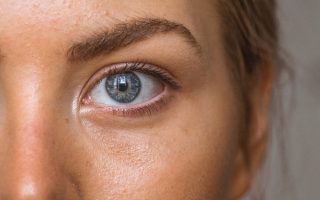Dry eyelids can be caused, for example, by the wrong care products or allergies to makeup. Dry eyelids often become noticeable in the evening or the morning.
Depending on the cause, the skin’s surface on the upper eyelid is roughened. Dry skin is often accompanied by itching and redness. The itching also drives the affected person to rub the eye more frequently, which causes redness.
The thin skin around the eyes is also susceptible and often reacts to mechanical stress with small cracks in the skin and swelling. If the corners of the eyes are affected, this can be accompanied by pain ( pain in the corners of the eyes ).
Dry eyelids caused by allergies often present with accompanying swelling and itching.
In neurodermatitis patients, the eyes are often severely affected by the disease. The upper eyelid is red, itchy and burns. Minor open wounds can develop. The skin appears wrinkled and scaly. Eventually, the dry skin that eventually rubs together on the upper eyelid can also cause mild pain.
Dry eyelids combined with dry lips
Dry eyelids often occur together with dry lips, especially in winter when the skin is exposed to constant, extreme change from cold, humid outside and warm, dry inside temperatures.
The skin in the area of the eyes, mouth and nose is susceptible. There are also mucous membranes in the immediate vicinity that are particularly sensitive to temperature fluctuations, loss of fluids and dry room air (heating air).
The skin of the lips is a so-called transition area from the mucous membrane of the mouth to the outer skin of the face. In this area, the protective horny layer is not yet as thick and well developed as that of the “normal” skin on the front, so it is clear that this area reacts more sensitively to stimuli and extreme situations than other parts the skin.
It is not uncommon, especially in winter, for the lips to become brittle and cracked and sometimes even to burst open and bleed.
Dry eyelids with scales
When the skin becomes dry, it often appears cracked and scaly; sometimes, even small scales can be observed to peel off. Dandruff in dry skin is the detachment of the top layer of skin, more precisely the horny layer, which can be supplied with little or no liquid.
The horny layer of the skin consists of dead skin cells, which are sloughed off at regular intervals as part of skin renewal. If the skin is dehydrated and lacks moisture, the skin cells cannot be supplied with sufficient nutrients, they die off more quickly, and the skin is forced to “recreate” faster and more often. The result is that visible desquamation occurs.
However, dry skin and dry eyelids with flaking cannot always be due to simple dehydration; sometimes, there can also be other causes that lead to the top layer of skin peeling and falling off.
Inflammatory reactions of the skin of any kind, whether allergic, infectious or autoimmune, can affect the skin so that it becomes dry, brittle, cracked and scaly – usually in the healing stage.
Dry eyelids and itching
Dry eyelids can sometimes be prone to severe itching, depending on the underlying cause and how extreme the dryness is. The dryness often makes the skin of the eyelids feel tight, which it is, and can sometimes flake and crack easily, both of which can cause itching. In addition, inflammatory or allergic skin diseases, for example, often have itching as a symptom.
Despite the itching, scratching in the area of the dry eyelids should be avoided as much as possible so that no loose skin is provoked. These form entry points for pathogens so that bacteria, for example, can trigger an additional infection in this area ( superinfection ).
Dry eyelids and eye wrinkles If the skin of the eyelids is dry, it often appears less taut and elastic.
If it loses moisture and becomes brittle, cracked and scaly, the natural skin relief is increased, and wrinkles can become more pronounced. Especially in the area of the eyelids, dry skin tends to be noticed by the fact that small skin wrinkles appear around the eye and on the eyelid itself, which were previously less visible or not present.


